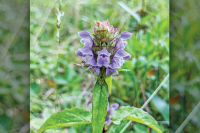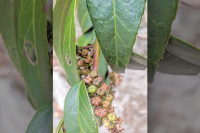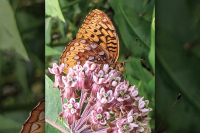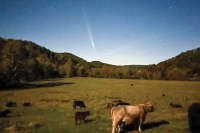Purging the pigs: Pilot program aims to knock back feral swine populations
 Feral swine live in family groups called “sounders.” USDA photo
Feral swine live in family groups called “sounders.” USDA photo
When Europeans first began exploring North America, they knew precious little about the land toward which they traveled — or what they’d find to eat once they arrived.
So, they added pigs to their roster of trans-Atlantic passengers, aiming to assure themselves of a delicious and reliable supply of meat on their journey through the New World. According to naturalist George Ellison, Christopher Columbus brought hogs to Cuba in 1493, and Hernando De Soto’s party was driving more than 300 swine by the time it reached the Great Smoky Mountains region in 1540.
Nearly 500 years later, the N.C. Department of Agriculture and Consumer Resources is launching a pilot program that aims to root these pigs’ descendants out of North Carolina. Through September 2023, residents of Haywood, Montgomery, Anson, Davie and Randolph counties can borrow high-tech corral traps designed to contain an entire family group of the invasive animals.
Feral swine cause soil erosion, which impacts water quality, and they’re vectors for at least 30 different diseases and nearly 40 types of parasites that can affect domestic pigs, other livestock, pets and even humans. They’re also incredibly destructive, capable of rooting up an entire field of crops.
“There’s just multiple angles by which they’re just bad news to have on the ground,” Owens said.

Related Items
- A large area of corn lies flat after a group of feral swine pass through. USDA photo
From necessity to nuisance
But that has not always been the official position of the Wildlife Commission, or the conventional wisdom among North Carolina residents.
De Soto and Columbus were not the first or only explorers to bring hogs to North America, and when European settlers arrived, they brought pigs of their own. The animals were typically allowed to free range on the land until it was time to round them up for slaughter — a low-cost, low-effort way for mountain families to keep meat on the table.
These pigs were not the same as the domestic stock farmers raise today, Owens said. Though still somewhat domesticated, they were a step closer to wild than modern pigs and didn’t reproduce quite as efficiently.
Those genetics got an extra dose of wildness in the early 1900s, when George Gordon Moore established a 1,600-acre game preserve on Hooper Bald in Graham County, stocking the property with buffalo, elk, mule deer, bears, turkeys, pheasant, sheep — and wild boar. Citing a 1959 Wildlife Resources Commission pamphlet by Perry Jones titled “The European Wild Boar in North Carolina,” Ellison wrote that, while most the animals succumbed to the pressures of an unfamiliar environment, the boars thrived. In fact, in the early 1920s a dog hunt on the boar herd, then estimated at 60-100 animals, resulted in only two dead boars but at least a dozen dead or maimed dogs.
“Some of the hunters were forced to take refuge in trees to escape the charging beasts,” Ellison wrote, quoting Jones. “Overly excited by the baying of dogs and shouts of hunters, the boar simply tore their way through the fence and escaped into the nearby mountains.”
Interbreeding with escaped domestic stock led to a population of hardy, elusive, intelligent animals thriving in scattered pockets throughout the state. For decades, official state policy ensured their success.
In the 1930s, when land managers began to realize that wildlife is not an unlimited resource, they implemented protections and restricted hunting seasons on a range of species — including feral swine. In 1979, the Wildlife Commission designated them a big game species, granting them an even higher level of protection.
But in 2011, the Wildlife Commission did “a complete 180,” said Owens, classifying feral swine as a non-game invasive species. Like coyotes, wild boars could now be hunted anywhere at any time. Growing scientific evidence of the boar’s negative impacts on environmental health and safety had led the Wildlife Commission to shift its management goal from protection to extermination.
“We do not want them on the landscape,” said Owens. “We want them gone.”

- Feral swine are skittish and avoid people, but evidence like tracks and rooted-up ground remains behind. Falyn Owens/NCWRC photo
That’s easier said than done. The pigs, which hang out in family groups called “sounders,” are prolific reproducers. Sows can have as many as 12 piglets in one litter, though three to eight is more common, and offspring typically reach sexual maturity at six to 10 months.
If the experience of the hunters at Hoopers Bald is any indication, pigs are difficult to kill. They’re also extremely smart, Owens said. If a hunter kills one member of a family group, the surviving pigs will learn from that experience. They won’t be huntable in the future.
Efforts to eradicate
The pilot program aims to address the problem by ensuring that when a landowner attempts to remove a troublesome family group of pigs, there are no survivors.
The traps, which resemble a livestock corral, are large enough to contain an entire family group of pigs and feature a remote trigger system that allows the operator to monitor the trap through a smartphone and close the gate when the entire group is inside. Patience is one of the biggest challenges to successfully using the traps, Owens said.
“We’re probably going to have to work hard to make sure that that the people who receive these traps have the patience to understand that success is going to be getting all of them,” Owens said. “Not a couple of them. Not most of them. All of them. And that takes patience.”
In North Carolina, it is illegal to release a live feral hog from a trap, meaning that trapped pigs must be euthanized — typically using a firearm — and then disposed of in a sanitary manner.
The traps cost about $10,000 apiece, meaning that without the loan program they would be out of reach to most landowners battling feral hog issues. The NCDACS, which is leading the effort in collaboration with a long list of partners, has purchased 50 of the traps using money from the Feral Swine Eradication and Control Pilot Program, which was established by the 2018 U.S. Farm Bill. The bill allocated $75 million for pilot projects to help farmers and producers fight against feral swine damage.

- Traps like these are now available for loan in five North Carolina counties, including Haywood. Falyn Owens/NCWRC photo.
“The point of the program is to figure out how we’re going to address it at a statewide level,” said Aaron Loucks, wildlife and livestock disease specialist for NCDACS. “That’s something that other states have been trying to also crack that code on.”
The traps had been available in Haywood County prior to the NCDACS program’s start in March 2021 through a program from the Haywood County Soil and Water Conservation District, Loucks said, so in Haywood the program is a continuation of that effort. The five counties were chosen based on the level of feral swine damage reported and risk of disease transmission from the animals.
“It’s not just pig farms. It’s also hunters,” Loucks said. “So if hunters are harvesting these animals to eat, and there’s a different zoonotic pathogen they could pick up, that’s a big problem.”
While feral swine have long been an issue in North Carolina, which reportedly had more pigs than any other colony in the New World, their range and impact has expanded in recent years. In 1982, only 19 states had documented feral swine populations. That number had risen to 28 by 2004 and now stands at 35, according to the U.S. Animal and Plant Health Inspection Service. The population is estimated at over 6 million “and is rapidly rising,” APHIS says, due to transport by humans, a lack of natural predators and the animal’s inherent adaptability.
“At a national scale, this is basically an unignorable problem,” said Owens.
The Farm Bill Funding aims to find innovative solutions to the feral swine issue that can translate to other communities across the country.
“As a country, we’ve gotten really, really hyper focused on states coming up with solutions that only work in their state,” Loucks said. “And since COVID, we’ve branched out a lot, and more states are communicating with more states at different levels, with the feds as well, to try to find solutions to more landscape-wide issues.”
The North Carolina program started in March 2021, with the initial phase focused on acquiring equipment and setting up the program. The equipment has been out for loan for some time now, and while Loucks said data on how many feral swine have been captured will not be available until the program’s conclusion, feedback from landowners has been positive.
“What we find out in North Carolina is going to serve as a model for the United States,” he said. “We’re looking at our obligations to other states around us as well — it’s a much bigger program than only Haywood. What we learn in Haywood is going to immediately be applied to other mountain states.”













